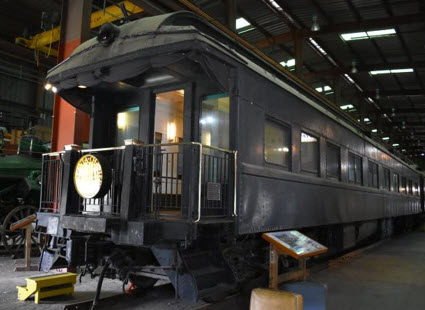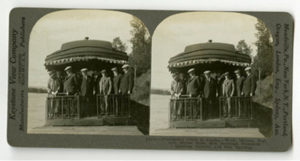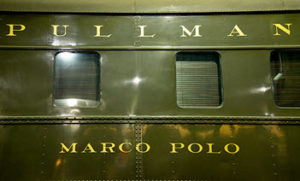
Celebrate President’s Day this weekend with a visit to the Southeastern Railway Museum where you can see two of these presidential trains. You can walk in the steps of President Harding on the Superb and FDR on the Marco Polo.
- President Lincoln’s administration originally built “The Lincoln Funeral Train” to carry President Lincoln throughout the United States after the Civil War. Sadly, the president never used the car while alive. After Lincoln’s assassination, the train was retrofitted as a hearse that would take him on a 1,654-mile journey. On April 21, 1865, more than 10,000 mourners watched the train leave Washington, D.C. The train passed through 180 cities in seven states.
- Benjamin Harrison traveled 10,000 miles across the U.S. by rail in 1891. The term POTUS (President Of The United States) was coined during Harrison’s administration as an identifying symbol on the train orders for his numerous special trains.
- The 1896 presidential campaign between William McKinley and William Jennings Bryan was the first conducted by rail. Bryan logged 10,000 miles and gave 3,000 speeches.
- Theodore Roosevelt was the first president to use an entire train dedicated to campaign staff. He used the train to deliver 673 speeches while traveling more than 21,000 miles. True to his reputation for adventure, Roosevelt often traveled in the locomotive cab and even learned how to operate drive a freight train.
- William Taft traveled more than 100,000 miles by rail during his 1909-1913 term, reaching every continental U.S. state except North Dakota.
- Woodrow Wilson in 1916 became the first sitting president to actively campaign for re-election, traveling more than 34,000 rail miles. In 1919, Wilson used a 10,000-mile train trip to convince the nation to support America’s entry into the League of Nations over the objections of Congress.
 Featured at the Southeastern Railway Museum! Warren G. Harding and wife, First Lady Florence Harding, embarked on the “Voyage of Understanding” on June 20, 1923 on the presidential car named “The Superb.” The journey was a two-month long trip and was intended to allow Harding a chance to personally connect with voters from the East Coast to Alaska and everywhere in between. Unfortunately, President Harding passed away during a stop in San Francisco, California where the president and his entourage were planning his return to Washington, D.C. “Although the “Voyage of Understanding” was originally intended to help a politician better understand his country, in the end, it enabled a country to remember its fallen leader.” (photo courtesy of The White House Historical Association)
Featured at the Southeastern Railway Museum! Warren G. Harding and wife, First Lady Florence Harding, embarked on the “Voyage of Understanding” on June 20, 1923 on the presidential car named “The Superb.” The journey was a two-month long trip and was intended to allow Harding a chance to personally connect with voters from the East Coast to Alaska and everywhere in between. Unfortunately, President Harding passed away during a stop in San Francisco, California where the president and his entourage were planning his return to Washington, D.C. “Although the “Voyage of Understanding” was originally intended to help a politician better understand his country, in the end, it enabled a country to remember its fallen leader.” (photo courtesy of The White House Historical Association) Featured at the Southeastern Railway Museum! Franklin D. Roosevelt traveled by rail for nearly 250,000 miles over 399 trips during his 12 years in office (1933-1945), the equivalent of 10 times around the world. He conducted several secret trips to boost morale at America’s military bases during World War II. He was the first president to have a train pulled by diesel locomotives in place of steam. The Marco Polo was fitted to assist Roosevelt with his limited mobility, a result of his bout with polio. It was used by the president as governor of New York and during his tenure as U.S. President. It was later replaced by the Ferdinand Magellan – a duplicate of the Marco Polo but heavily armored to protect the president during WWII.
Featured at the Southeastern Railway Museum! Franklin D. Roosevelt traveled by rail for nearly 250,000 miles over 399 trips during his 12 years in office (1933-1945), the equivalent of 10 times around the world. He conducted several secret trips to boost morale at America’s military bases during World War II. He was the first president to have a train pulled by diesel locomotives in place of steam. The Marco Polo was fitted to assist Roosevelt with his limited mobility, a result of his bout with polio. It was used by the president as governor of New York and during his tenure as U.S. President. It was later replaced by the Ferdinand Magellan – a duplicate of the Marco Polo but heavily armored to protect the president during WWII.- Harry Truman, expected to lose re-election in 1948 according to polls and pundits, covered 30,000 rail miles in the last months of his campaign. He delivered more than 300 speeches to an approximately six million people and succeeded in convincing Americans to return him to office. Truman later said, “I went by train. I wanted to talk to them face to face. I knew that they knew that when you get on television, you’re wearing a lot of powder and paint that somebody else has put on your face, and you haven’t even combed your own hair.”
- Dwight Eisenhower was the last president to make regular use of train travel – mostly because Mamie, his wife, hated flying. During his 1952 campaign, Eisenhower traveled more than 51,000 miles, making 232 stops. Many of those miles were by air for Dwight, but Mamie stayed on the train the entire time.
- Lyndon Johnson, heeding advice from Truman years before, sent his wife Lady Bird Johnson to conduct the campaign by rail in 1964. The “Lady Bird Special” is the first time a first lady had campaigned for her husband. Lady Bird’s press secretary said, “There, from the back of the train, is where the government and the people meet.”
- Ronald Reagan conducted a one-day whistle stop tour from Dayton to Toledo in 1984. He borrowed the Ferdinand Magellan, FDR’s armored rail car, for the 133-mile excursion.
- On October 18, 2005, during a ceremony near the George Bush Presidential Library and Museum, the Union Pacific Railroad unveiled Locomotive No. 4141 named after and in honor of the 41stPresident of the United States, George H.W. Bush. The engine pulled the 41st president to his final resting place in 2018 from Spring to College Station, Texas. The locomotive can now be seen at the George H.W. Bush Presidential Library and Museum.
————————————————————————————
BIBLIOGRAPHY
“Experience the Union Pacific Rail Car.” up.com. Union Pacific, January 2017. https://www.up.com/cs/groups/public/@uprr/@newsinfo/documents/up_pdf_nativedocs/pdf_up_media_experience_up.pdf.
“Noteworthy Presidential Trains.” National Railroad Museum. Accessed February 16, 2022. https://nationalrrmuseum.org/blog/notable-presidential-trains/.
“President Harding’s Voyage of Understanding, Alaska, Side A.” Digital Library. White House Historical Association. Accessed February 16, 2022. https://library.whitehousehistory.org/fotoweb/archives/5017-Digital-Library/Main%20Index/Presidents/Warren%20G%20Harding/1111977.tif.info.
“President Harding’s Voyage of Understanding.” WHHA (en-US). White House Historical Association. Accessed February 16, 2022. https://www.whitehousehistory.org/digital-library/projects/president-hardings-voyage-of-understanding.

Be the first to comment